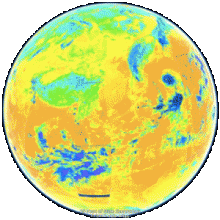Featured Content
 |
U.S. Secretary of State John Kerry Stops by the HyperwallThe Earth Observing System (EOS) Science Program Support Office (SPSO) organized and coordinated NASA’s Hyperwall presence at Our Ocean Conference 2014, hosted by U.S. Secretary of State John Kerry. The meeting took place at the U.S. Department of State in Washington, DC, June 16-17, 2014. Several senior-level managers from NASA Headquarters and Goddard Space Flight Center used the Hyperwall to deliver presentations highlighting NASA’s role in studying Earth’s ocean from space. On day two of the meeting, John Kerry and environmental activist and American actor and film producer Leonardo DiCaprio visited the Hyperwall. To learn more and to view photos from the event, check out the September-October issue of The Earth Observer newsletter. |
 |
ISS-RapidScat Mission BrochureNASA’s International Space Station Rapid Scatterometer, or ISS-RapidScat, is the first scientific instrument specifically created to observe winds from the space station. Successfully launched on September 21, 2014, the experimental mission (described in this brochure) will measure ocean-surface wind speeds and directions, providing data that are needed to support weather and marine forecasting—including tracking storms and hurricanes—and climate research. The space station’s unique orbit will allow ISS-RapidScat to make the first direct observations of how ocean winds vary over the course of the day. |
 |
Integrating Carbon From the Ground Up: TCCON Turns TenIn May 2004 a new approach for studying greenhouse gases in our atmosphere came from an unlikely source: a lone trailer in Park Falls, WI. Now a decade later, TCCON has expanded and provides important information about regional and global atmospheric levels of carbon-containing gases from many stations worldwide. |
 |
Dark Data Rescue: Shedding New Light on Old PhotonsThis article, from the May-June issue of The Earth Observer newsletter, recounts a fascinating effort to coax life—and science—out of data that were collected during the 1960s (from Nimbus 1, 2, and 3). |
 |
SMAP Mission BrochureIn January 2015, NASA will launch the Soil Moisture Active Passive (SMAP) mission. SMAP (described in this brochure) is NASA’s first Earth-observing satellite mission designed to collect continuous global observations of surface soil moisture and freeze/thaw state every 2-3 days at 3 to 40 kilometer (~2 to 25 mile) spatial resolution. |
 |
OCO-2 Mission BrochureIn July 2014, NASA launched the Orbiting Carbon Observatory-2 (OCO-2) mission. OCO-2 (described in this brochure) is the first NASA satellite dedicated to monitoring carbon dioxide, and it will do so with greater precision and detail than current instruments. |
 |
The Earth Observer: Twenty-Five Years Telling NASA’s Earth Science StoryIn March 2014, The Earth Observer newsletter celebrated its twenty-fifth anniversary. This article reflects on those 25 years, including memories and reflections of some key events in Earth Observing System (EOS) history from those who participated in its development. |
 |
An Update on the Aquarius Mission: Two-and-a-Half Years and Going StrongThis article, published in the January-February issue of The Earth Observer, highlights some of the data products being generated by the Aquarius/SAC-D mission and novel scientific findings, including tips on how to access these resources. |
 |
GPM Core Observatory BrochureThe Global Precipitation Measurement (GPM) mission, co-led by NASA and JAXA, centers on the GPM Core Observatory and consists of a network of additional satellites that together will provide next-generation global observations of precipitation from space. This brochure describes the specifics of the GPM Core Observatory (launched in February 2014) and its role in the GMP mission. |
